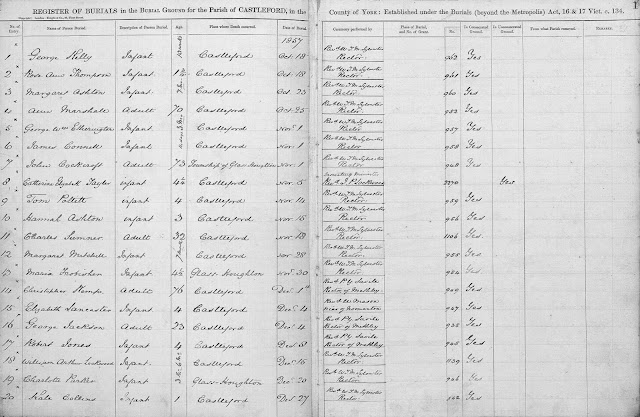Around 75% of burial and cremation records for Wakefield Metropolitan District are now on Deceased Online
Last week, I looked into the history of the metropolitan district of Wakefield. In this post, I look more closely at its cemeteries and the coverage of their records in the Deceased Online database.
Wakefield district contains nineteen cemeteries and two crematoria. Of these 261,000 burial and 134,000 cremation records, a total of approximately 395,000, are being uploaded to the database. Many of the records go back to the mid and late 19th century when the cemeteries opened (see the list below), and range across a wide geographical area.
Currently, approximately 230,000 of the total are available. Please note the details in our database coverage section of the website to see which records with dates can be searched now.
Below is a screenshot of a Google Map showing the locations of Wakefield Council's cemeteries and crematoria and their proximity to notable cities in the area, such as Leeds. The map can be explored in more detail online.
The nineteen cemeteries, with opening dates in brackets, are as follows:
1. Altofts Cemetery – Church Road, Altofts, Normanton (1878)
2. Alverthorpe
Cemetery – St Paul’s Drive, Alverthorpe, Wakefield (registers from 1955)
11. Normanton
Upper Cemetery – Neville Street, Normanton (1876)
Currently, all burial records are available on the database for Alvethorpe, Castleford, Crigglestone, Featherstone, Ferrybridge, Horbury, Outwood, Ryhill, Sharlston, Snydale, Stanley, and Whitwood cemeteries. Although, Knottingley was laid out in 1859, records are only available from 1883. Of these, all can be searched now.
The largest cemetery in this collection is Wakefield at around 68,000 burial records. At present, 7,000 can be searched.
The second largest is Castleford Cemetery with around 37,900 records, of which all are on the database. Castleford is divided into two sections by Headfield Road. The side with the Keeper's Lodge is known as the 'New Cemetery' and the other section is referred to as the 'Old Cemetery'. A third section is known as 'Castleford New Extension'. You will find reference to these terms at the cemetery and in the 'location' section of the Burial Register Summary on the Deceased Online website. If you have army ancestors from this region, you may be interested to know that there are a large number of military graves in this cemetery.
The two crematoria in the Wakefield collection are:
1. Pontefract Crenatorium, Wakefield Road, Pontefract (1959)
2. Wakefield Crematorium (1961)
82, 600 records for these two crematoria are currently available to search online out of a total of around 134,000.
We continue to receive updates on our Facebook and Twitter pages from users who have found their ancestors in our collections. Do let us know if you find any of your family members in the Wakefield cemeteries!
Last week, I looked into the history of the metropolitan district of Wakefield. In this post, I look more closely at its cemeteries and the coverage of their records in the Deceased Online database.
Wakefield district contains nineteen cemeteries and two crematoria. Of these 261,000 burial and 134,000 cremation records, a total of approximately 395,000, are being uploaded to the database. Many of the records go back to the mid and late 19th century when the cemeteries opened (see the list below), and range across a wide geographical area.
Currently, approximately 230,000 of the total are available. Please note the details in our database coverage section of the website to see which records with dates can be searched now.
Below is a screenshot of a Google Map showing the locations of Wakefield Council's cemeteries and crematoria and their proximity to notable cities in the area, such as Leeds. The map can be explored in more detail online.
The nineteen cemeteries, with opening dates in brackets, are as follows:
1. Altofts Cemetery – Church Road, Altofts, Normanton (1878)
3. Castleford Cemetery – Headfield Road, Castleford (1857)
4. Crigglestone
Cemetery – Standbridge Lane, Crigglestone, Wakefield (1882)
5. Featherstone
Cemetery – Cutsyke Road, North Featherstone (1874)
6. Ferrybridge
Cemetery – Pontefract Road, Ferrybridge, Pontefract (1924)
7. Hemsworth
Cemetery – Cemetery Road, Hemsworth (1896)
8. Horbury
Cemetery – Dovecote Lane, Horbury, Wakefield (1897)
9. Knottingley
Cemetery – Womersley Road, Knottingley (1859)
10. Normanton Lower Cemetery – Cemetery Road, Normanton (1880)
12. Outwood
Cemetery – Leeds Road, Outwood, Wakefield (1873)
13. Pontefract
Cemetery – Skinner Lane, Pontefract (1859)
14. Ryhill
Cemetery – Cemetery Road, Ryhill, Wakefield (1898)
15. Sharlston
Cemetery – Cow Lane, Sharlston, Wakefield (1946)
16. Snydale
Cemetery – Red Lane, Streethouse (1880)
17. Stanley
Cemetery – Lake Lock Road, Stanley, Wakefield (1886)
18. Wakefield Cemetery – Doncaster Road, Wakefield (1859)
19. Whitwood
Cemetery – Cutsyke Road, Four Lane Ends, Castleford (1926)
 |
| First page of the Register of Burials for Castleford Cemetery (now Castleford Old Cemetery) showing burials from October 1857 |
The second largest is Castleford Cemetery with around 37,900 records, of which all are on the database. Castleford is divided into two sections by Headfield Road. The side with the Keeper's Lodge is known as the 'New Cemetery' and the other section is referred to as the 'Old Cemetery'. A third section is known as 'Castleford New Extension'. You will find reference to these terms at the cemetery and in the 'location' section of the Burial Register Summary on the Deceased Online website. If you have army ancestors from this region, you may be interested to know that there are a large number of military graves in this cemetery.
The two crematoria in the Wakefield collection are:
1. Pontefract Crenatorium, Wakefield Road, Pontefract (1959)
2. Wakefield Crematorium (1961)
82, 600 records for these two crematoria are currently available to search online out of a total of around 134,000.
We continue to receive updates on our Facebook and Twitter pages from users who have found their ancestors in our collections. Do let us know if you find any of your family members in the Wakefield cemeteries!

Comments
Post a Comment